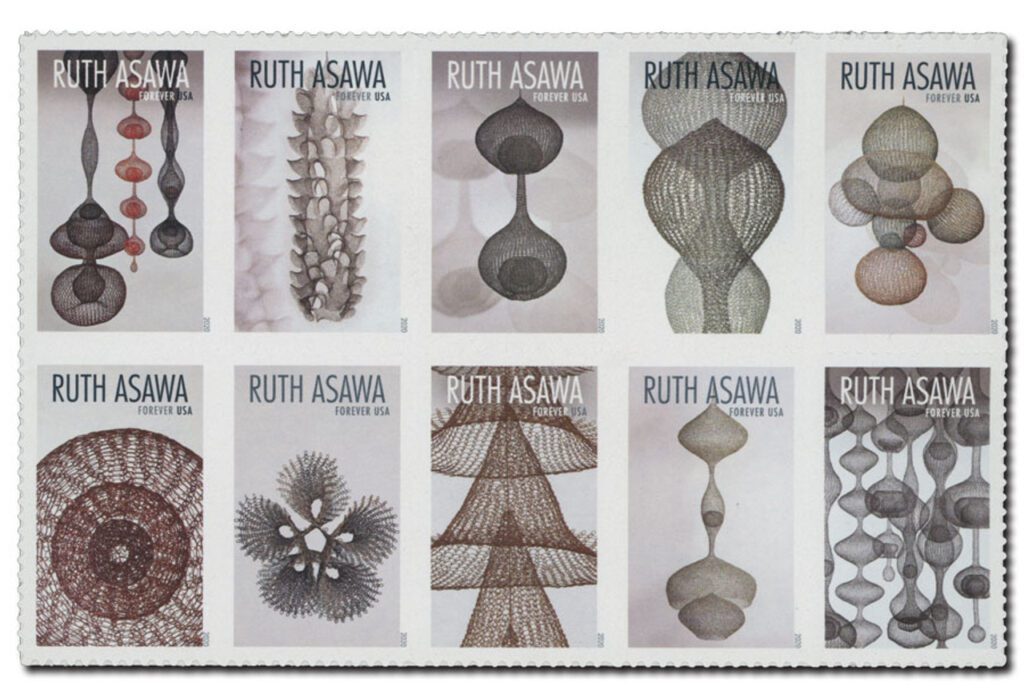Artist Ruth Aiko Asawa was born on January 24, 1926, in Norwalk, California.
As a child, Asawa worked long hours on her family’s farm while also attending school. Following the attack on Pearl Harbor, Asawa, like many Japanese-Americans, was sent to an internment camp. In spite of the harsh conditions, Asawa remained positive and creative.

While in the camp, Asawa took art classes from internees who were animators at Walt Disney Studios. She then received a special release to attend Milwaukee State Teacher’s College to become an art teacher. However, she was prevented from student teaching out of concerns over anti-Japanese sentiment.
Attending Black Mountain College from 1946 to 1949 was one of the most formative experiences of Asawa’s life. Black Mountain College was an experimental school where students and teachers worked the school’s grounds. Students and teachers worked together, both in class and out, creating a close-knit community. One aspect of the school that had a deep impact on Asawa was the encouragement to use everyday items in art. While she originally saw herself as a drawer and painter, she found great joy in creating sculptures out of objects like egg shells and leaves.
In 1947 Asawa went to Mexico and watched local artists crochet egg baskets. She was intrigued by their technique and the way they took flat materials and transformed them into three-dimensional objects. Upon returning home, Asawa adopted this weaving technique using wire, which was available in abundance on the farm where she lived. She was fascinated by the “possibilities of transforming cold metal into shapes that emulate living organic forms.”
While she began weaving baskets, Asawa soon started using the wire to recreate her own drawings as well as objects from nature. Asawa’s sculptures usually began with a center stem with anywhere from 200 to 1,000 wires. These wires then branched out into geometric forms. Both the inside and outside of Asawa’s sculptures were visible. The sculptures enclosed the space without concealing it. When hung from the ceiling, the shadows they cast became part of the artwork itself. This was often considered the hallmark of her work. Asawa saw her work as a way of drawing in space – which could only be done with a line, because, as she stated, “a line can go anywhere.”
In addition to her wire sculptures, Asawa became a popular figure in San Francisco for her public art projects. Her first commission was a fountain in 1968. She designed so many fountains over the years, she became known as the “Fountain Lady.” Perhaps her most famous is the San Francisco Fountain, built for the Grand Hyatt. In addition to fountains, Asawa was also commissioned to produce a number of reliefs and sculptures.
Asawa was also an active art education activist. She believed schools needed better art resources and dedicated many years to improving art education. She helped found the Alvarado School Arts Workshop, which brought parents and professional artists to schools to help improve art education. Asawa also founded SCRAP, a non-profit organization that offers free or low-cost art supplies to schools. It’s still in operation today.
Asawa also worked on the San Francisco Arts Education Project, the Commission on Mental Health’s Role of the Arts committee, and the California Arts Council. She fulfilled a long-time dream in 1982 when she opened the San Francisco School of the Arts. It is still open today, renamed the Ruth Asawa San Francisco School of the Arts. It is recognized as a “California Distinguished School,” one of the state’s most “exemplary and inspiring public schools.”
Asawa died in San Francisco on August 5, 2013.
Click here to view some of Asawa’s art.
| FREE printable This Day in History album pages Download a PDF of today’s article. Get a binder or other supplies to create your This Day in History album. |
Click here to see what else happened on This Day in History.




